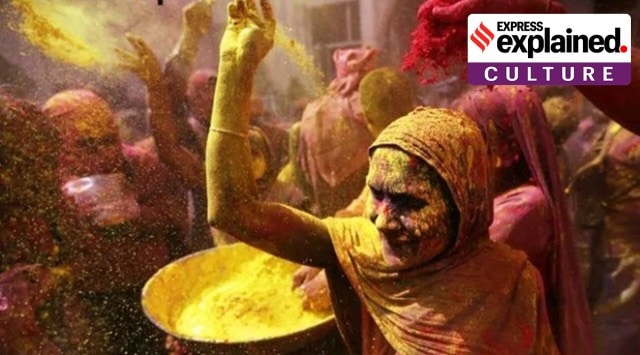Latest Comment
Post Comment
Read Comments
 Widows playing Holi at the historic Gopinath Temple in 2018. (Express Photo by Gajendra Yadav)
Widows playing Holi at the historic Gopinath Temple in 2018. (Express Photo by Gajendra Yadav) Vrindavan, considered to be the place where Lord Krishna spent his childhood, has for centuries been a refuge for widowed Hindu women. Shunned by society, the widows of Vrindavan live difficult lives, dependent on charity from the State, NGOs and the many temples and ashrams of the holy town.
Widowhood, especially among caste Hindus, has always carried deep social stigma. From the practice of sati to taboos regarding widows’ presence on auspicious occasions, losing one’s husband comes with a loss of social standing for many women. They are expected to dress in white and lead lives of extreme austerity, making ‘devotion to God’ the central aim of their lives. Often considered a drain on family finances, many widows find themselves in holy places such as Varanasi and Vrindavan.
Yet, each year, Holi brings some colour to the stark lives of Vrindavan’s widows. Traditionally barred from participating in festivities, nowadays, Holi has become a festival where widows shun custom and tradition to engage in some fun.
“It is our life, and we must live it, and hope for better in the next,” a widow told The New York Times in 1998. There is a similar sense of resignation running through many testimonies of Vrindavan’s widows.
Today, thousands of widows live in Vrindavan, most of them from Bengal – a 2010 study by the National Commission of Women (NCW) put the number at 74 per cent. It is believed that widows have gathered in the city since Chaitanya Mahaprabhu, a 16th-century saint and social reformer from eastern India, brought a group of them there to escape sati, a now-banned practice in which caste Hindu widows immolated themselves on their husbands’ funeral pyres.
While many widows come to Vrindavan of their own accord, some escape physically and mentally abusive situations at home, while others are simply abandoned at Vrindavan.
“Colour vanished from my life after my husband died. I was just 20. I could not wear colourful clothes, or apply lali (colour) on my lips. I was shooed away from functions,” 108-year-old Lalita Adhikari told The Indian Express in 2014. She spent over 70 years in Vrindavan.
Vrindavan may free widows from the indignities of living with their families, but destitution brings its own despair. Many widows spend their days begging for alms from the devotees who flock to the city. Others take on odd jobs for paltry remunerations. Almost all live in poverty or are very close to it.
The NCW 2010 report says, “The opportunities and facilities available in Vrindavan enable women to acquire two square meals a day and escape the taboos and harassment otherwise imposed upon them.” But, since a large proportion (nearly 90 per cent) are unlettered, with many unfit for physical labour due to old age, two square meals is about the best they can get.
“Does it feel good?” 70-year-old Rada Rani Biswas responded when asked about her life by CNN. “Now I have to loiter just for a bite to eat.”
White clothing is the most overt marker of widowhood among Hindus and it symbolises a relinquishment of worldly attachment and desires. On an average day, Vrindavan’s musty lanes are filled with women in white, many begging and singing hymns about Lord Krishna.
However, Holi has provided a welcome change in recent years. Challenging antiquated customs that deny widows both colour and enjoyment, Holi has become a period where women who have suffered at the hands of fate, break out of the shackles imposed upon them by society.
They dance, sing traditional Holi songs in Brij Bhasha and most importantly, play with colourful gulal, flowers and coloured water. “We have no words to express our joy,” widows Vimla Dasi (65), Ratania Devi (67) and Chhaya (66) told PTI in unison in 2022.
While there may have been isolated instances of widows playing Holi before, the first major celebration by widows was organised in 2013. This was after the Supreme Court brought focus to the plight of the widows in 2012, in response to a PIL filed by National Legal Services Authority. NGOs such as Sulabh International, which takes care of more than 1500 widows in Vrindavan, have spearheaded the change.
“The celebration was a way of telling them they are one of us. They can wear coloured clothes, eat what they want. The ones who want to remarry, can,” Dr Bindeshwar Pathak, founder of Sulabh, told The Indian Express in 2014.
Since then Sulabh has organised ever larger Holi celebrations for widowed women. This year, widows celebrated Holi on Monday (March 6) in the historic Gopinath Temple in Vrindavan. In the audience were hundreds of devotees, including many foreigners, reported PTI.
Things have undoubtedly improved since 2012, reported The New York Times in 2019. A spurt of investment and renewed focus followed the very public 2012 case where the Supreme Court weighed in on the matter. But for many widows, the trauma suffered at the hands of their families continues to weigh heavily. So does poverty.
While widows celebrating Holi is a welcome change, it by no means makes up for the continued destitution and social ostracisation they face. As Lalita Adhikari had told The Indian Express in 2014, “The state of widows is not going to change by playing Holi once.”